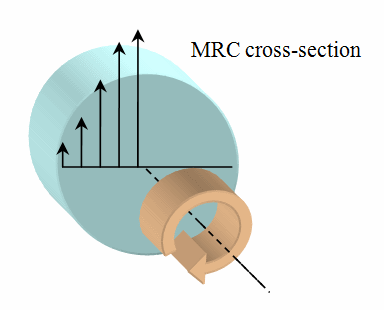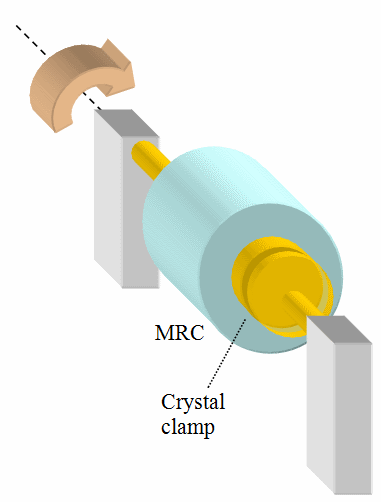Rotating MRCs and RIMs
In this series
It helps to think once more about what happens when the crystal becomes type saturated. In most of the cases the crystal turns into ordinary matter e.g. diamond or another crystalline carbon structure, or in some cases into hydrogen gas or a massive burst of high-energy photon radiation. As catastrophic as this discharge can occur, it is usually just a fraction of the energy stored in that specific type saturation. Most of the energy disappears into what can be best described as implosion towards regions of higher interaction frequencies i.e. frequencies greater than the ones defining the Spacetime domain. If this process (which is like any causal process non-instantaneous) occurs irregularly throughout the MRC it is when the crystal can shatter at great speeds due to the extreme changes in material properties and the arising shear forces. Combined with the great rotational speeds that can be accredited to the crystal’s ‘suprafluid’ core, you have to cope with a particle wave of devastating mechanical power leaving everything in its wake pulverized.
Rule number one: Keep your big MRCs in bunkers.
Nonetheless the deeper reason for all those secondary effects is the implosion of the type imbalance away from our Spacetime domain. Such imbalance is created in the crystal when e.g. photons and electrons are used to generate a mass field.
What happens when the critical type saturation point is reached? We remember that such a crystal is best described when it is assumed that its internal structure, rotate at very high speeds around the crystal’s rotational axis.

The arrows represent the magnitude of the angular velocity at a given distance from the MRC core. Velocity should not be necessarily understood as spatial velocity – it is rather the oscillation of the medium’s properties in relation to the surrounding Spacetime-continuum.
In the case of the crystal reaching a critical type saturation point, the implosion moves from the surface of the crystal towards its rotational axis. This can be counteracted by rotating the crystal. And because the crystal has no weight, some quite astonishing revs can be achieved! From the perspective of the 4Band, the limit to the achievable rotation arises from the material properties of the clamp whose basic design we discussed in the previous section. I already mentioned that those are not very good.

Still, considering that the crystal possesses no mass in its unsaturated state, maybe 1’000 revs / second can be achieved. Beyond this magnitude the centrifugal force overcomes the clamp’s internal bonding. Of course, this in itself is quite dangerous. With the clamp breaking apart, the crystal remains attached to some of the parts. This looks quite ridiculous - you would never expect such a sizeable object to fly around at speeds of much smaller objects. Remember though, that the crystal has no mass. And remember also that the crystal has a very disordering effect when it is hit by matter (or flies through it).
Rule Number 2: Make sure the inner walls of your bunker are bridge-coated. A bridge-coating will be able to interact with the crystal as if it is solid in the classical sense and stop it quite effectively.
All this becomes even more interesting when we combine rotating crystals with particle streams. To explain the intricate resonances that occur in such a scenario would take us too far, I will nonetheless deviate a little bit.
Consider once more the spatial blurriness of particles existing within the MRC’s space domain. Through careful interaction it is possible to create something like a ‘super-atom’ with the MRC at its core that is surrounded by numerous particles tied up in complex interaction with each other and the MRC – in its completeness a spatial entity which interacts with our environment mainly through electromagnetism. The outer shell of the particle web therefore consists mainly of electrons that behave according to the surrounding electromagnetic field. Once we enter deeper layers of the particle matrix we encounter electrons that have a greater affinity to interact with the rotating MRC, thereby becoming a key component for a RIM*). They can be set up such that they resemble the behaviour of electrons within an atom or within molecular structures – All this regardless of the pretty sizeable diameter of the MRC. By setting up and ‘charging’ a RIM, the effect of increased spatial blurriness (not necessarily the feature of ‘hiding type from spatial causality’) that is inherent to the MRC is expanded into the space surrounding the Crystal. It creates an environment that has similarities to the internal structure of an atom. Much like electrons can reach ‘calm waters’ within the atom system by orbiting at diameters that are directly related to the Planck constant, they can also do so within a RIM with far greater diameters.
Deeper layers show behaviour that becomes more exotic. Particles are found that change type during their orbiting, complex entanglements between e.g. protons and electrons emerge. A RIM is somewhat like a magnifying glass – It focuses onto an atomic structure and blows it up into dimensions that can be measured in metres. Along the spatial dimensions everything else is blown up, too. The magnitudes of energy encountered, the lifetime of particles, their spatial blurriness all become magnified, such that e.g. an electron-positron connection (positronium) can survive for seconds and can reach a spatial blurriness that covers a good deal of the RIMs total size.
In case you were wondering: RIMs vary greatly in size and shape, depending on the application. Technically, the smallest RIMs use spherical MRCs about 5 cm in diameter, while the total size of the RIM is also spherical and maybe about 20-30 cm in diameter. On Swarm ships of the biggest class, about 10-30 kilometres in size, you may find MRCs in use that are cylindrical and about 20 metres in diameter. With a cylindrical shape a typical bunker core must cater for RIMs with a diameter of up to 300 metres.
If we strain the analogy to the model of a Hydrogen atom, the proton in the core is comparable to the MRC within a Rotating Interaction Matrix. It shares e.g. the behaviour of returning very quickly energy that is tried to be pressed into the RIM. A complete energetic chaos or very highly charged particles can be created just by fiddling a bit with the RIMs energy state. We are talking here of a saturated, or fully charged, stable RIMs. While limits are imposed by the strength of the Generators that help sustain the electromagnetic tomb and the possibilities of the Particle stream generators, the MRC also brings along a natural limit, known as the RIM saturation point. Overdoing this point can be quite unspectacular or not, depending on how stable the RIM had been before it was ‘overdone’. The MRC’s characteristic of interacting at greater interaction frequency bands becomes predominant and the complete RIM, i.e. the crystal and the surrounding particle web is sucked into the crystal’s fastest rotating axle. It now depends on whether the crystal keeps its properties to the bitter end, where the complete entity simply disappears without a trace. Normally a minuscule part of the crystal will fall into normal spatial behaviour (compare to the MRC’s saturation point), generating a lot of energetic chaos. A good deal of the energy usually reappears inside a sun as members of the particle zoo we know from Spacetime by following higher order interaction frequencies related to gravitational force fields. This can indeed be measured and it can actually affect a sun, but normally a sun is in comparison far too big and stable as to be destroyed by such an event.
More dangerous for a crew can be the scenario where the MRC’s characteristic of interacting at higher interaction frequencies becomes disturbed. Here most of the forces stored in the particle web cannot find a channel into the MRC and away from the spatial confinement of an electromagnetic field. A direct effect is a very explosive reaction, which can then itself disturb the MRC so much that it also releases stored energy from greater interaction frequencies into Spacetime. This is the worst-case scenario of a RIM breakdown and leads to sure death of the whole Spacecraft. With the improvements over the millennia, such accidents are extremely rare. The sustainment of a perfectly aligned RIM has reached such perfections that in cases of misuse, the reaction is usually a near complete implosion that can be dealt with. Of course such situations have to be avoided due to the sheer value of MRCs.
*)
An acronym preferably used in advanced text books on the subject. It stands for ‘Rotating multi-resonance Interaction Matrix’ and denotes the complete system of a rotating MRC with a surrounding particle web that is perfectly aligned to the requirements of Iilasian technology.